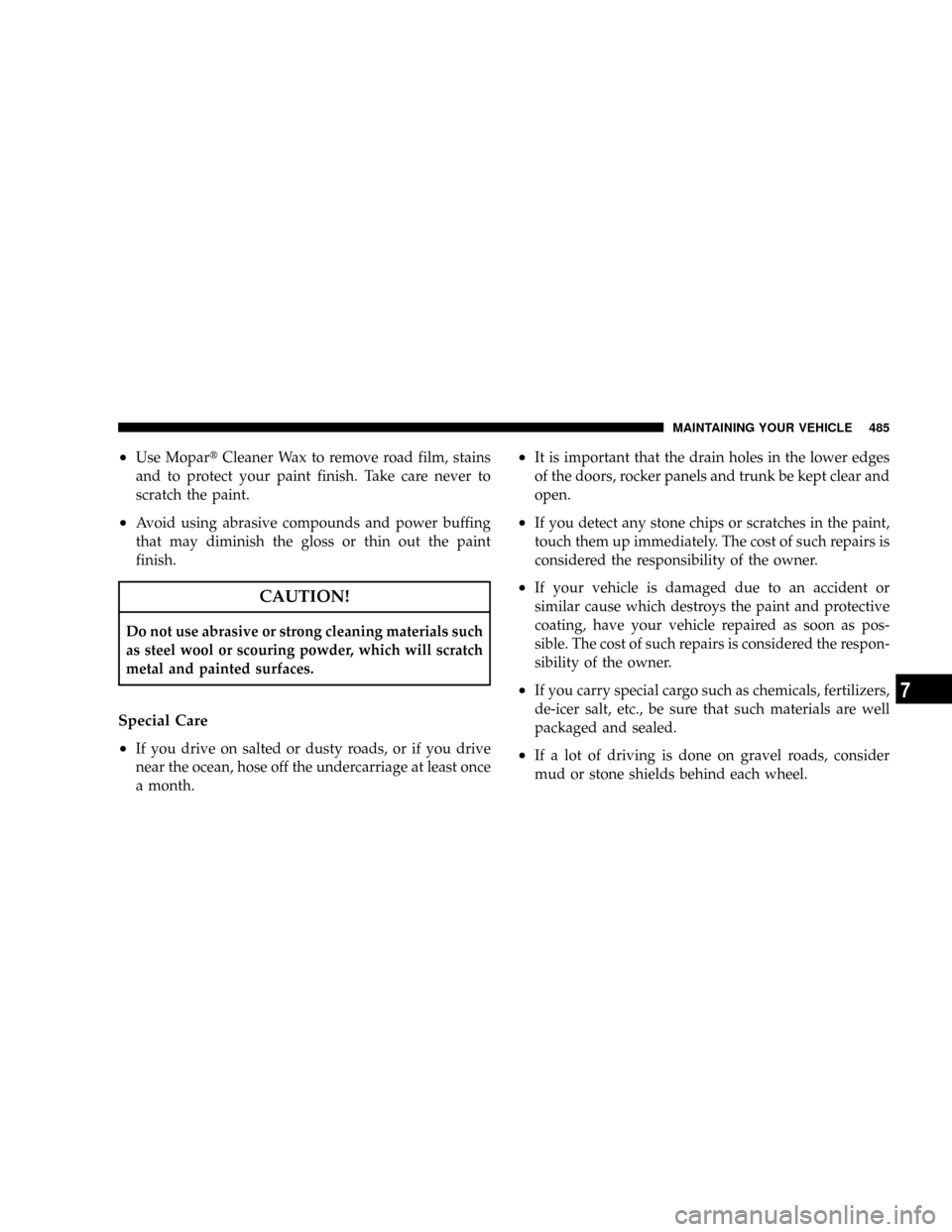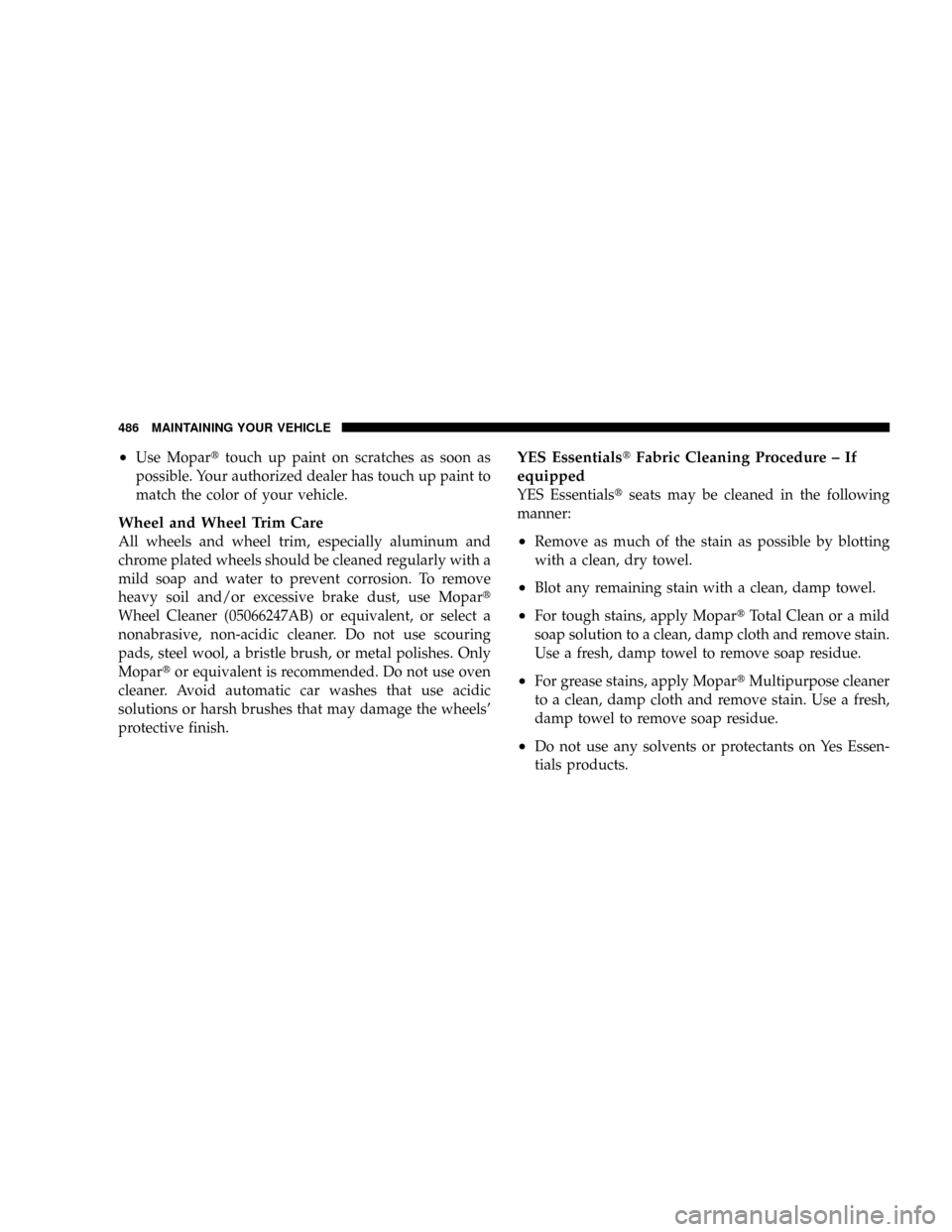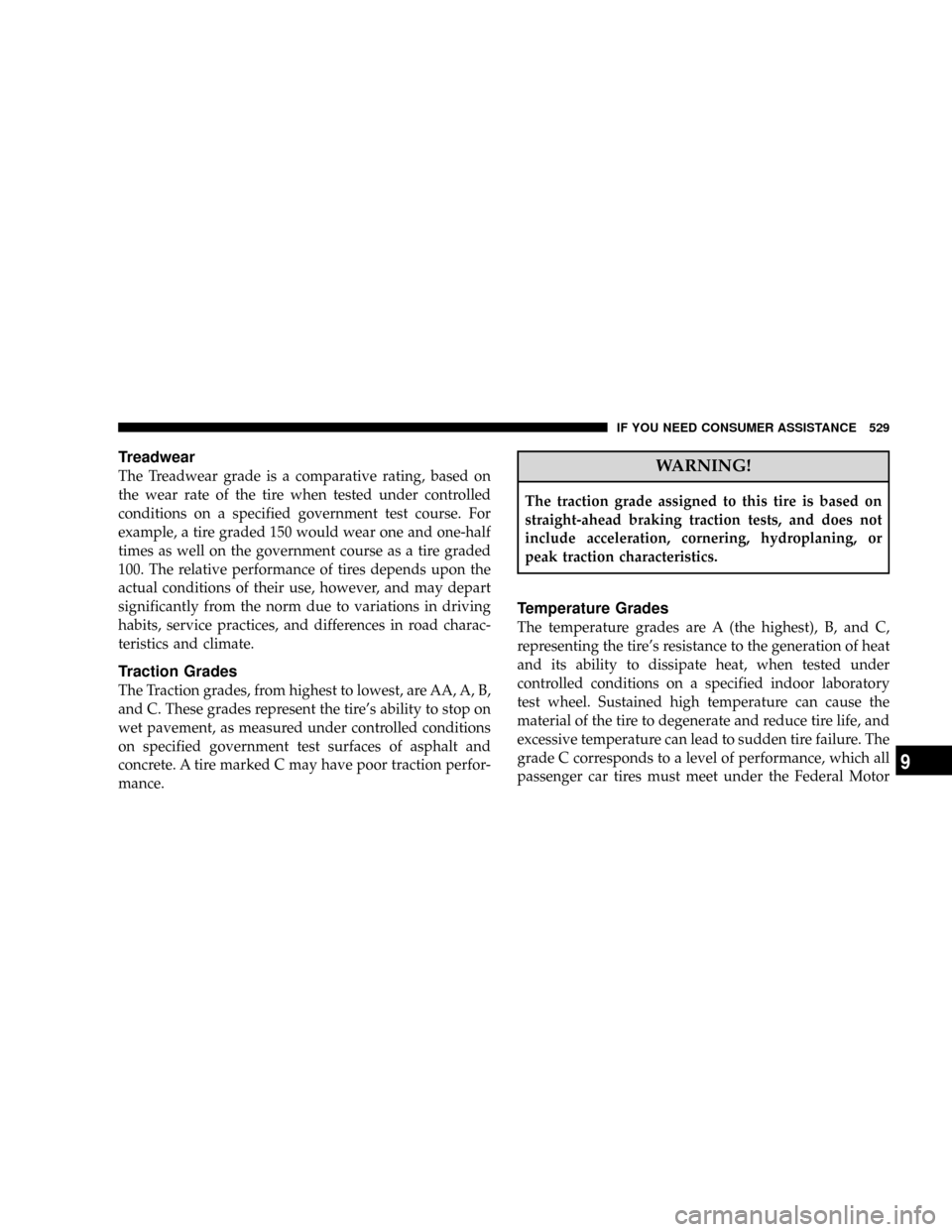Page 487 of 554

²Use MopartCleaner Wax to remove road film, stains
and to protect your paint finish. Take care never to
scratch the paint.
²Avoid using abrasive compounds and power buffing
that may diminish the gloss or thin out the paint
finish.
CAUTION!
Do not use abrasive or strong cleaning materials such
as steel wool or scouring powder, which will scratch
metal and painted surfaces.
Special Care
²
If you drive on salted or dusty roads, or if you drive
near the ocean, hose off the undercarriage at least once
a month.
²It is important that the drain holes in the lower edges
of the doors, rocker panels and trunk be kept clear and
open.
²If you detect any stone chips or scratches in the paint,
touch them up immediately. The cost of such repairs is
considered the responsibility of the owner.
²If your vehicle is damaged due to an accident or
similar cause which destroys the paint and protective
coating, have your vehicle repaired as soon as pos-
sible. The cost of such repairs is considered the respon-
sibility of the owner.
²If you carry special cargo such as chemicals, fertilizers,
de-icer salt, etc., be sure that such materials are well
packaged and sealed.
²If a lot of driving is done on gravel roads, consider
mud or stone shields behind each wheel.
MAINTAINING YOUR VEHICLE 485
7
Page 488 of 554

²Use Moparttouch up paint on scratches as soon as
possible. Your authorized dealer has touch up paint to
match the color of your vehicle.
Wheel and Wheel Trim Care
All wheels and wheel trim, especially aluminum and
chrome plated wheels should be cleaned regularly with a
mild soap and water to prevent corrosion. To remove
heavy soil and/or excessive brake dust, use Mopart
Wheel Cleaner (05066247AB) or equivalent, or select a
nonabrasive, non-acidic cleaner. Do not use scouring
pads, steel wool, a bristle brush, or metal polishes. Only
Mopartor equivalent is recommended. Do not use oven
cleaner. Avoid automatic car washes that use acidic
solutions or harsh brushes that may damage the wheels'
protective finish.
YES EssentialstFabric Cleaning Procedure ± If
equipped
YES Essentialstseats may be cleaned in the following
manner:
²Remove as much of the stain as possible by blotting
with a clean, dry towel.
²Blot any remaining stain with a clean, damp towel.
²For tough stains, apply MopartTotal Clean or a mild
soap solution to a clean, damp cloth and remove stain.
Use a fresh, damp towel to remove soap residue.
²For grease stains, apply MopartMultipurpose cleaner
to a clean, damp cloth and remove stain. Use a fresh,
damp towel to remove soap residue.
²Do not use any solvents or protectants on Yes Essen-
tials products.
486 MAINTAINING YOUR VEHICLE
Page 497 of 554
LIGHT BULBS Ð Exterior Bulb No.
Tail & Stop............................3057
Cab Clearance Lights...................... 168
Dual Rear Wheel Sidemarker Light............ 168
Dual Rear Wheel Tailgate ID Lights (3)......... 168
BULB REPLACEMENT
Headlight (Halogen)/Front Park and Turn Lights
CAUTION!
This is a halogen bulb. Avoid touching the glass with
your fingers. Reduced bulb life will result.1. Open the hood
2. Remove the two bolts from the front of the headlight
housing.
Front Headlight Housing Bolts
MAINTAINING YOUR VEHICLE 495
7
Page 507 of 554
Tailgate ID Lights (Dual Rear Wheels) Ð If
Equipped
1. Remove the two screws and housing and access the
bulb sockets from the rear.
MAINTAINING YOUR VEHICLE 505
7
Page 508 of 554
2. Turn socket1¤4turn counterclockwise to access the
bulb.
3. Pull bulb straight out from socket.
4. Reverse procedure for installation of bulbs and hous-
ing.Rear Light Bar ID Marker (Dual Rear Wheel) Ð If
Equipped
1. Loosen the two screws and the housing to gain access
to the bulb sockets.
2. Turn the socket
1¤4turn counterclockwise to access the
bulb.
506 MAINTAINING YOUR VEHICLE
Page 509 of 554
3. Pull the bulb straight out from the socket.
4. Reverse procedure for installation of bulbs and hous-
ing.
Side Marker Lights (Dual Rear Wheels)
1. Push rearward on the side marker light assembly.2. Pull the entire assembly from the fender.
3. Turn socket
1¤4turn counterclockwise and remove from
assembly to access the bulb.
4. Pull bulb straight out from socket.
5. Reverse procedure for installation of bulbs and hous-
ing.
MAINTAINING YOUR VEHICLE 507
7
Page 531 of 554

Treadwear
The Treadwear grade is a comparative rating, based on
the wear rate of the tire when tested under controlled
conditions on a specified government test course. For
example, a tire graded 150 would wear one and one-half
times as well on the government course as a tire graded
100. The relative performance of tires depends upon the
actual conditions of their use, however, and may depart
significantly from the norm due to variations in driving
habits, service practices, and differences in road charac-
teristics and climate.
Traction Grades
The Traction grades, from highest to lowest, are AA, A, B,
and C. These grades represent the tire's ability to stop on
wet pavement, as measured under controlled conditions
on specified government test surfaces of asphalt and
concrete. A tire marked C may have poor traction perfor-
mance.
WARNING!
The traction grade assigned to this tire is based on
straight-ahead braking traction tests, and does not
include acceleration, cornering, hydroplaning, or
peak traction characteristics.
Temperature Grades
The temperature grades are A (the highest), B, and C,
representing the tire's resistance to the generation of heat
and its ability to dissipate heat, when tested under
controlled conditions on a specified indoor laboratory
test wheel. Sustained high temperature can cause the
material of the tire to degenerate and reduce tire life, and
excessive temperature can lead to sudden tire failure. The
grade C corresponds to a level of performance, which all
passenger car tires must meet under the Federal Motor
IF YOU NEED CONSUMER ASSISTANCE 529
9
Page 532 of 554
Vehicle Safety Standard No. 109. Grades B and A repre-
sent higher levels of performance on the laboratory test
wheel, than the minimum required by law.WARNING!
The temperature grade for this tire is established for
a tire that is properly inflated and not overloaded.
Excessive speed, under-inflation, or excessive load-
ing, either separately or in combination, can cause
heat buildup and possible tire failure.
530 IF YOU NEED CONSUMER ASSISTANCE